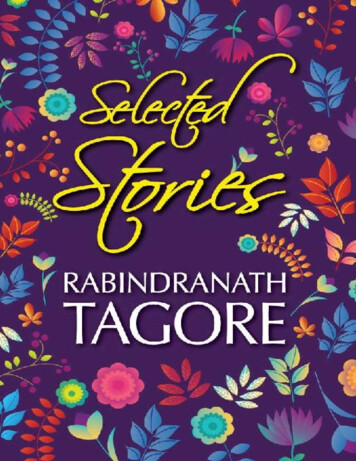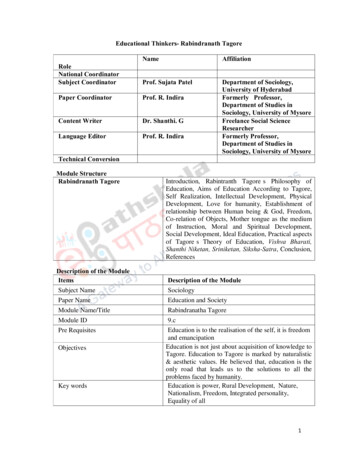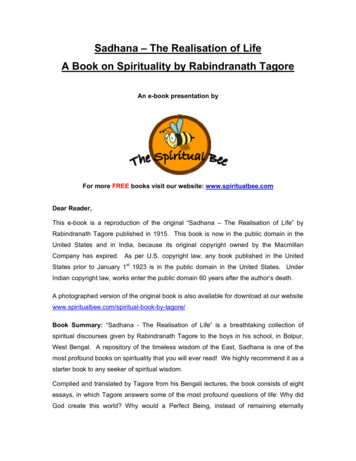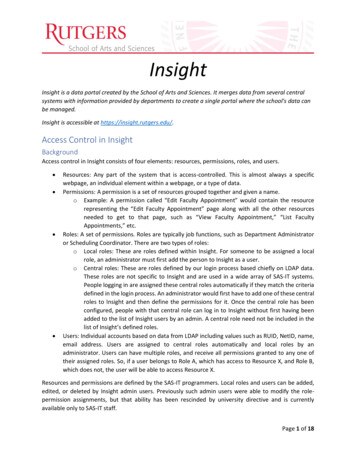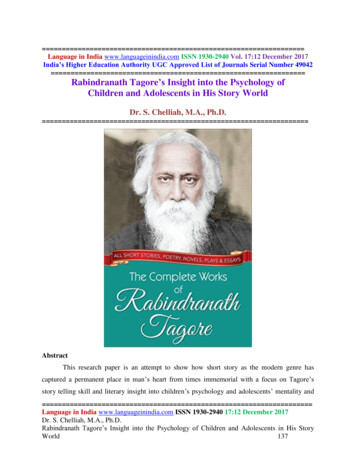
Transcription
Language in India www.languageinindia.com ISSN 1930-2940 Vol. 17:12 December 2017India’s Higher Education Authority UGC Approved List of Journals Serial Number 49042 Rabindranath Tagore’s Insight into the Psychology ofChildren and Adolescents in His Story WorldDr. S. Chelliah, M.A., Ph.D. AbstractThis research paper is an attempt to show how short story as the modern genre hascaptured a permanent place in man’s heart from times immemorial with a focus on Tagore’sstory telling skill and literary insight into children’s psychology and adolescents’ mentality and Language in India www.languageinindia.com ISSN 1930-2940 17:12 December 2017Dr. S. Chelliah, M.A., Ph.D.Rabindranath Tagore’s Insight into the Psychology of Children and Adolescents in His StoryWorld137
his treatment of women and emotional aspects of human beings reflected and projectedeffectively in his short stories.Keywords: Short story, Rabindranath Tagore short stories, emotional aspects, humanrelationship, children’s psychology, adolescents’ mentality.Short Story and TagoreIt is generally held that from time immemorial, short stories have captured a permanentplace in man’s heart. There is no doubt, Tagore’s insight into children’s psychology, histreatment of women and emotional aspects of human beings in his short stories have won quite alot of readers for him and these aspects have stayed for ever in the readers’ minds. It isunderstood out and out by all that Tagore’s stories are stories of human relationships, humanitybeing represented in the concrete endowed with elemental emotions as also with those which arebred through social ties. Tagore himself said rather evidently as:“If I do nothing else but write short stories I am happy and I make a few readers happy.The main cause of happiness is that my characters, become my companions, they are withme. When I am shut in my room on a rainy day and on a sunny day, they walk about withme on the bright banks of the Padma” (qtd in Kripalani 159).The short story is one of the earliest literary forms. Over the last one hundred and fiftyyears, the short story has come to figure conspicuously in the literature of several countries.Short stories are the most widely read of all modern genres, even from ancient days. Stories weretold for the intrinsic value and entertainment.World in a CapsuleShort stories are found to have captured the attention of children and adults alike.Generally speaking, a short story is a world in a capsule and varied strands form the texture of ashort story. In this busy world, one may lose continuity while reading a novel but one is quiteimpressed while reading a short story. The short story has firmly established itself as a favourite Language in India www.languageinindia.com ISSN 1930-2940 17:12 December 2017Dr. S. Chelliah, M.A., Ph.D.Rabindranath Tagore’s Insight into the Psychology of Children and Adolescents in His StoryWorld138
form in modern literature. Its immense popularity is the result of many co-operating causes;among them, the rush of modern life which has made men impatient of those ‘great still books’as Tennyson called them, which were popular in the past.Short story has become so popular that extraordinary claims are at times put forth on itsbehalf. Modern age is, no doubt, noted for its hectic activities, its speed. Everything is availablein a condensed form. Hence the popularity of the short story is growing. Though short in its span,this genre packs a lot of punch in it. In fact, a writer can be very emotive while writing a shortstory. Short story is the only outlet for a large and varied experience for those who cannot read anovel or watch the television with sustained interest. As a result, people prefer the short story tonovel or television.Charmed by Short StoryTruly speaking, short story intends to entertain and describe an interesting event. It isalmost as old as man himself. It began very early in human history. Our ancestors, getting boredwith the strenuous struggles of daily life, thought that concocting a tale would amuse them.Children and grown-ups, all alike, are charmed by the short story. In caters to two of thestrongest and deepest human instincts – the desire to amuse and the desire to teach. The customof narrating in the ancient ages was popular in the East as well as in the West. A. C. Ward pointsout that Jesus Christ told many short stories. Some of the earliest stories are found in the Vedasand the Upanishads. Stories in the Old Testament, in the Buddhist Jatakas, in Panchatantra andin the Katha Sarit Sagar, The Fables of Aesop and Mythological Stories have always been asource of knowledge and delight. Brief and short stories are found in the Sangam Literature aswell. The short story has now established its identity as a distinct art form demanding thegreatest care and constructional skill on the part of the writer.Principles of Modern Short Story and Modern Originators of Short StoriesIt is said that the principles of modern short story were first of all formulated byNathaniel Hawthrone and Edgar Allan Poe and both are said to have laid stress on the Language in India www.languageinindia.com ISSN 1930-2940 17:12 December 2017Dr. S. Chelliah, M.A., Ph.D.Rabindranath Tagore’s Insight into the Psychology of Children and Adolescents in His StoryWorld139
“singleness of effect” and “final impression” as the hallmarks of a good story. WashingtonIrving was the first great American writer who in the midst of his periodical sketches, producedstories like Rip Van Winkle and The Legend of Sleepy Hollow. In seeking the inventor of themodern short story, a clearer case might be made for Hawthorne or Poe. In 1830, both of themstarted their work in the field of short story about ten years after the publication of Irving’sSketch Book. During the nineteenth century, publication of magazines increased greatly, givingan impetus to this genre. The history of the modern short story embraced diverse tendencies.Nineteenth century critics often insisted on the need for a firmly developed plot design inany short story. H.G. Wells in his definition of the short story emphasizes on its brevity and callsit,“The jolly art of making something very bright moving; it may be horrible or pathetic orfunny or profoundly illuminating, having only this essential, that it should take from 15 to30 minutes to read aloud” (Sengupta 292).In brief, it may be said that a short story is nothing but a recital of events and any piece ofbrief functional prose can be regarded as a short story, provided it retains a plot. A good shortstory may be written on almost any theme dealing with any kind of motive and material.Though the short story flourished on the Indian soil, it is the West which gave it a perfectliterary form. The short story took the form of literature once it started reflecting the happeningsin real life. Though Gautama the Buddha and Christ were master story tellers, they did not seekto shape it into a perfect art form, as their focus was primarily teaching the people aroundmorals, etc. Only through modern writers like Poe, Hawthorne, R. K. Narayan and Tagore andgreat writers in Indian languages, such as Pudumaipithan in Tamil, short story came to staycarving a niche for itself as a literary form by perfect character-portrayal, neat plot constructionand picturization of interesting incidents. Language in India www.languageinindia.com ISSN 1930-2940 17:12 December 2017Dr. S. Chelliah, M.A., Ph.D.Rabindranath Tagore’s Insight into the Psychology of Children and Adolescents in His StoryWorld140
In the words of Anima Bose, “ the essential ingredient of a short story is a particularmoment amidst the monotony of routine daily life called out by the author’s own experience andsensitivity” (P 52).A Distinct Place for Short Story in Bengali LiteratureIn Bengali literature, the modern short story is a unique product of the nineteenth centuryduring which Bengal witnessed many upheavals in politics as well as in social customs. It madeits appearance rather suddenly and just as in Europe it was given importance through thenumerous magazines which gave a tremendous boost to this genre.Rabindranath Tagore and Short StoryWith the arrival of Rabindranath Tagore, short story writing received the impetus it wasin need of. Tagore’s first story Bhikarini was published when he was only sixteen years old. AsKrishna Kripalani puts it,“ in the short stories, he showed himself a master almost from the very beginning. Hefollowed no known model or pattern. There was none in his own country and its literarytradition. He was the first Indian to attempt this form proper” (P 153).World Literature and Short StoryIn world literature, we have a good number of eminent short story writers likeMauppasant and Balzac in France, Chekhov, Tolstoy, Zurgenev, Pushkin, Dostoyevsky andGogol in Russia, Edgar Allan Poe, O’Henry and Hawthorne in America and Maugham andChesterton in England. In the words of Anima Bose,“in the pre-Tagorean era imagination and fancy pre-dominated. Reality, flesh and bloodhad not yet engaged the attention of Bengali writers ” (P52).Tagore’s WorldIt is said that the Russian classics have the candour of the soul, the French classics havethe candour of the mind and Tagore’s stories have the candour of feeling. Kripalani comments: Language in India www.languageinindia.com ISSN 1930-2940 17:12 December 2017Dr. S. Chelliah, M.A., Ph.D.Rabindranath Tagore’s Insight into the Psychology of Children and Adolescents in His StoryWorld141
“he was a poet in the traditional Indian sense of the world, Kavi, a seer, an intermediarybetween the human and the divine. His genius enriched whatever it touched” (p. 2).Tagore was highly imaginative and deeply sensitive. Kripalani observes:“like the sun after which he was named , he shed light and warmth on his age, vitalizedthe mental and moral soil of his land, revealed unknown horizons of thought and spannedthe arch that divides the East from the West” (P 2).Tagore explored every field of literary activity. He even created new literary forms. Hisstories reveal the perennial springs of life. His short stories are woven around a variety of themesand his stories probe the inner recesses of mind. Hence, his stories have a universal appeal.Every story Tagore has written shines like a gem.Even though a short story is narrated, the characters in his stories play an active anddramatic part in evoking pity in the reader’s heart. No doubt, Tagore was a keen observer of thelife of men and women with its spontaneity and its problems, its joys and sorrows, its happinessand tragedies and its motives – potent or underlying and he described it all in his poems, novelsand short stories. He wanted not a political but a social revolution.Tagore appeals for the unity and consolidation of all the people of India, regardless ofrace, language and religious beliefs. He feels that only friendship and cooperation with all peoplecould serve as a firm basis for the progress and well-being of India. His stories make usunderstand how we must live in unity, eradicate racial discrimination and fight against violenceand exploitation.Tagore and Children and WomenVariety, it is believed, is the spice of life. Tagore in his own competent manner capturedthe nuances of life and placed them before us crystallized in an artistic form. Krishna Kripalaniobserves, Language in India www.languageinindia.com ISSN 1930-2940 17:12 December 2017Dr. S. Chelliah, M.A., Ph.D.Rabindranath Tagore’s Insight into the Psychology of Children and Adolescents in His StoryWorld142
“Always seeking the great in the small,he found ample material in the lives ofthe common folk for his short stories” (153).Tagore was sensitive to the joys and sorrows of the common man. He understood thefeelings and psychology of the people he met every day. He was deeply interested in childrenand when we approach the question of characterization in his stories the figures that flit before usare mostly those of women and children. Tagore was interested in the education and upbringingof children. His own childhood was austere and, as a shy boy, he shrunk into an isolated cornerindignantly reacting against his sheltered life. Tagore was full of sympathy for children whowere forced to lead a constricted life, whose zest for life was stifled by the overprotected adults.Truth and love are the only values that find acceptance in the child’s world, which is neitherdifferent from the world of grown-up men and women nor unaware of the false standards of theletter. A child loves and longs for affection and recognition. One should not think of children asunderdeveloped and unintelligent title models of adults incapable of judging between good andbad, true and false. There is no doubt that cruelty to children is the greatest of all evils. Childrenare tender, sensitive, generous, imaginative, sometimes fierce and often sad.Tagore’s child characters are mostly meditative creatures with an inward life, wild andwayward in their rebellion against the prison regime of society. Tagore, the greatest writer, wrotefor children and about children, presenting rather vividly problems faced by the children, theirloneliness, the cruelty experienced by them and their longing for love and affection. His storiestell us about unhappy children – orphans living with relatives, misunderstood by them, theirchildish pranks too severely punished, unattractive adolescent children longing for love,dependent child whose pride is humbled to dust. The focus is on these miserable creatures wholong for freedom, love and happiness.To be a writer for children, one must come down from adult height and merge with thechildren. Tagore had a keen insight into a child’s psyche. An ordinary aspect would assume a Language in India www.languageinindia.com ISSN 1930-2940 17:12 December 2017Dr. S. Chelliah, M.A., Ph.D.Rabindranath Tagore’s Insight into the Psychology of Children and Adolescents in His StoryWorld143
great significance for Tagore. The child’s inviting look and its longing for love and affectionprovide the themes for Tagore’s stories. He is not a passive observer of children’s outward naturebut a deep analyser of their feelings.Being a keen student of child’s psychology, Tagore enters into a world of the child’s ownmaking, sympathises with his unspeakable joys and ununderstandable sorrows and catches thechild’s fancies in all their vividness and description.The PostmasterIn The Postmaster, Tagore portrays the love and affection of a small orphan girl for thepostmaster. The postmaster, stationed in the village of Ulapur, feels like a fish out of water.Ratan, a young orphan worked as his maid. This orphan girl of twelve was his only companion.The postmaster chatted with Ratan about his own home, his mother and sister. The little girlRatan also told him about her parents and a little brother with whom she had played. Theirconversation about their past family life draws them nearer and the attempt of the postmaster toeducate the child strengthens the friendship. One cloudy morning, she found the postmaster inbed. At once, she called in a doctor, gave him medicines, cooked his gruel and nursed him. Thepostmaster’s illness and the care bestowed by the child who nursed him back to health deserveappreciation. When the postmaster recovered, he applied for a transfer to Calcutta. As hisapplication was rejected, he made up his mind to resign his job. When he broke this news to thechild, she was silent, but when he finished his supper, she asked him whether he could take herhome with him. The postmaster only laughed and exclaimed, “what an idea”. The whole night,the answer haunted the little girl. Before leaving, he offered her some money which she refused.Then the postmaster started for Calcutta. When he was in the boat,“ . the rain swollen river, like-stream of tears welling up from the earth, swelled andsobbed at her bows, then he felt a sort of pain at heart, the grief-stricken face of a villagegirl seemed to represent for him the great unspoken pervading grief of mother earthherself” (The Postmaster 168). Language in India www.languageinindia.com ISSN 1930-2940 17:12 December 2017Dr. S. Chelliah, M.A., Ph.D.Rabindranath Tagore’s Insight into the Psychology of Children and Adolescents in His StoryWorld144
The postmaster reciprocated Ratan’s feelings, but to him the idea of taking the girl, homewith him was absurd. Musing over the girl, he had thought to go back and bring her along withhim; but the boat was already in the middle of the turbulent waters of the river. The village wasleft far behind. The postmaster goes back to his old world, but what about the orphan girl? Theyoung girl, who did not know any philosophical approach to life was only longing for the love ofher companion. The idealistic approach of the girl to love is contrasted with the adult’s practicalapproach. The story ends on a philosophical note:“So the traveler, borne on the breast of theSwift flowing river, consoled himself withphilosophical reflections on the numberlessmeetings and partings going on in the world on death, to great parting, from whichnone returns” (The Postmaster 169).The Home ComingThe Home Coming (chutti) reveals the keen insight of the author who probes into themind of a fourteen-year old boy. Home Coming is the story of a boy of high spirits not yetsubjected to the rigours of discipline. It is an excellent story of the adolescent mind of PhetikChakravarthy, the village lad who was the ring leader among the boys of the village. Phatiknever get sympathy, understanding or love and as K. R. S. Iyengar, commenting on Phatik’s fatewrites;“The one hunger that none can suppressnot even the deaf and dumb, not even a backwardchild is the hunger for understanding andsympathy and love” (P 69).The tragedy of Phatik was that he never got this understanding and sympathy from anyquarters. Phatik was involved in some mischief every day, and he decided to shift a heavy logwith the help of his friends. Makhan, his brother, acted as a barrier for Phatik’s plan andamusement. Makhan was firm and did not get up from the log. The log was rolled along with Language in India www.languageinindia.com ISSN 1930-2940 17:12 December 2017Dr. S. Chelliah, M.A., Ph.D.Rabindranath Tagore’s Insight into the Psychology of Children and Adolescents in His StoryWorld145
Makhan. To his mother, Phatik was an eternal nuisance lazy, disobedient and wild. Makhankicked Phatik and reported to his mother that Phatik had hit him. This resulted in Phatik’s anger.Not able to accept his lie, he beat Makhan severely. Phatik’s fate changed and his trouble startedfrom this point. When her brother Bishamber offered to take Phatik off his sister’s hands andeducate him with his children in Calcutta, she was immensely relieved and she immediatelyagreed to the proposal. His aunt was by no means pleased to see Phatik as she had enough tomanage, with her own three boys. As Tagore observes;“In this world of human affairs, there is noworse nuisance than a boy at the age of 14.He is neither ornamental nor useful”(The Home Coming 36)Phatik felt like a fish out of water in the stifling atmosphere of his aunt’s house. Histortured soul was full of anguish, as he realised that he was an unwelcome guest. The elderlylady despised him and insulted him on every occasion for,“it is easy to excuse the shortcomings ofearly childhood, but it is hard to tolerateeven unavoidable lapses in a boy of fourteen.The lad himself becomes painfully self-conscious”(The Home Coming 37)Yet it is in adolescence that a young lad most longs for love and recognition and hebecomes devoted to anyone who is kind to him. Thackeray said that nobody feels injustice orshrinks before a slight hurt and “has a sense of wrong so acute and so glowing a gratitude forkindness, as a generous boy” (P86). For Phatik, his own house is the only paradise. To live in astrange house with strange people is little short of torture for him. He yearned for love andunderstanding. It was painful to Phatik to be an unwelcome guest in his aunt’s house. Phatik,repelled by his aunt’s cruelty wanted to go back to his village. Phatik’s heart craved for love andhe longed to go back to the open country. It is true that nothing seems more engaging for thechild’s mind than being caressed in his mother’s arms. Every night, he dreamt of his village Language in India www.languageinindia.com ISSN 1930-2940 17:12 December 2017Dr. S. Chelliah, M.A., Ph.D.Rabindranath Tagore’s Insight into the Psychology of Children and Adolescents in His StoryWorld146
home – the lovely meadow where he played with his kite, the river bank where he wanderedabout singing and shouting joyfully and the brook where he dived and swam. And aboveeverything else, “the true memory of that tyrant mother of his, who had such a prejudice againsthim, occupied him day and night” (The Home Coming 38).Phatik was the most backward boy in the class and when he lost his text book, the teachercaned him mercilessly. When he informed his aunt about the loss, she shouted at him. The samenight, he had an attack of malaria fever and feared that he would be a great nuisance to his aunt.The next morning, the boy had disappeared and Bishamber had to inform the police. At the endof the day, two constables carried him home. He was thoroughly drenched and was shivering.When the aunt exclaimed that he was a heap of trouble and Bishamber ought to send him home,Phatik sobbed out that he was just going home, but they dragged him back. A doctor was broughtbut the boy was delirious. He asked his uncle if the holidays had come and whether he could gohome. His excited voice called out to his mother, imploring her not to beat him as he was tellingthe truth. The next day, his condition became critical. Later on, his mother arrived like a stormand began to lament. Phatik’s restless movements stopped as he turned his head and withoutseeing anybody said, “Mother the holidays have come” (The Home Coming 40).A small event created a bitter feeling in Phatik. He was too young to bear too much ofscoldings, abuse and face a change of life. Makhan’s lie, the brutality of his mother, the crueltyof his aunt everything had driven Phatik to a state of agony and sorrow. Phatik’s fun-filleddays turned into a nightmare because of Makhan. Phatik craved for affection and love.It is remarkable how Tagore has analysed the sensitivity of the boy’s mind. Thus, TheHome Coming leaves an indelible mark on the reader’s mind. Tagore’s understanding of thethoughts and feelings of a fourteen-year-old boy is so amazing that one would imagine that hehad done research in child psychology. Lila Ray Comments:“Rabindranath discovered and lost his mother on the threshold of adolescence, betweenthe ages of thirteen and fourteen. All this long repressed and neglected need of live and Language in India www.languageinindia.com ISSN 1930-2940 17:12 December 2017Dr. S. Chelliah, M.A., Ph.D.Rabindranath Tagore’s Insight into the Psychology of Children and Adolescents in His StoryWorld147
affection, a need intensified by the first stirrings of an interest in women as woman roseto the surface only to be thwarted. The emotional ferment into which he was plungedmade him exceedingly restless” (P 32).Through Phatik, Tagore tells us what can happen to a child when he is nagged by afeeling of restlessness and insecurity. It is no wonder that he has given such a realistic picture ofa child in the transitional stage. Tagore’s picturization of the agonies of adjustment faced byPhatik in his aunt’s house shows his deep insight into the psyche of children.SubhaSubha is the story of a young dumb girl who is ironically named Subhashini (sweetspoken) by her father. Tagore portrays Subha as a victim of the unjust customs of society. Hertwo elder sisters were married with some difficulty and Subha, the youngest was a source ofworry to her parents. Banikanta, Subha’s father loved her more than his other daughters; hermother regarded her with aversion as a stain upon her own body. As for Subha,“She had understood from her earliest childhood that God had sent her like a curse to herfather’s house, so he withdrew herself from ordinary people and tried to live apart. If onlythey would all forget her, she felt she could endure it” (Subha 145).Although Subha could not speak, her black eyes expressed all her feelings. Other childrenwere afraid of Subha and did not play with her. Banikantha’s house was on the banks of astream, the waves of which beat upon the restless soul of the girl. Nature seemed to speak forher,“ . beneath the west impressive heavens therewere only dumb Nature and a dumb girlsitting very silent one under the spreadingsunlight, the other where a small treecast its shadow” (P 148). Language in India www.languageinindia.com ISSN 1930-2940 17:12 December 2017Dr. S. Chelliah, M.A., Ph.D.Rabindranath Tagore’s Insight into the Psychology of Children and Adolescents in His StoryWorld148
Subha had two friends who were dumb like her, Sarbashi and Panguli, the two cows intheir stall. They understood her better than man could. When she was hurt, she would go to themfor consolation and the dumb creatures understood the anguish of her spirit. Her only comradeamong human beings was Pratap, an idle fellow. In the afternoon, Pratap loved to catch fish andhe liked Subha’s company. Subha longed to be of some help to Pratap. But that beingimpossible, she sat by him as he cast his line and prepared some betel leaves for him. As Subhagrew up, she was filled with a new consciousness. One full noon night, she opened her door andlooked out. As Nature, as lovely as Subha, looked down upon the sleeping earth, Subha wasfilled with an infinite sadness. Her heart was heavy with loneliness and she could not speak. Herparents were anxious about her marriage as people threatened to make them outcastes. SoBanikanta went away for a few days and on his return said that they must go to Calcutta.Preparations were being made to go to that strange place but Subha’s heart was filled with aforeboding. It was Pratap who informed her that they had found a bridegroom for her and shewas to be married:“As a stricken doe looks in the hunter’s face, asking in silent agony; ‘what have I done toyou?’ So Subha looked at Pratap” (P 153).That afternoon, instead of sitting beneath her tree, Subha fell at her father’s feet andgazing at him, burst out weeping. Banikantha, Subha’s father, also wept and tried to console her.As they were to leave for Calcutta the next day, Subha went to the cow shed to bid farewell toher childhood playmates. She wept as she embraced them. Then she went to the river bank andflung herself on the grass. In Calcutta, the bridegroom came with a friend one day to see thebride and Subha wept copiously. He thought that one who had such a tender heart would prove tobe a priceless possession. The wedding took place on an auspicious day. The bridegroom leftwith his wife for the west where he worked. Within fifteen days, everyone knew that Subhabecame dumb. She longed to see the faces familiar from childhood;“In her silent heart, there sounded anendless, voiceless weeping, which only thesearcher of hearts could hear” (P 155). Language in India www.languageinindia.com ISSN 1930-2940 17:12 December 2017Dr. S. Chelliah, M.A., Ph.D.Rabindranath Tagore’s Insight into the Psychology of Children and Adolescents in His StoryWorld149
Her husband decided to marry a second time. He married a girl who could speak. One canneither forget the beautiful picture of Subha’s silent friendship nor the biting satire of the socialcustoms that condemned Subha to misery and loneliness. One has to blame the cruel society inthe early twentieth century, a society which could not allow a helpless dumb girl to live in herfamiliar surroundings, but push her into an alien world. Subha’s parents were only eager to gether married. They were not concerned about her happiness or welfare. Blind belief andsuperstition did not allow them to foresee the pain and misery which their beloved daughterwould suffer in her new name. It was against such blind superstitious practices that a man likeRaja Ram Mohan Roy revolted. Roy brought about “a crusade against institutionalizedoppression and degrading social and religious practices such as Sati, Polygamy and idolatory”(Raj 6). For Tagore, rigidity and conservatism which resist progress and change are the greatestenemies of life.CabuliwallahCabuliwallah is a beautiful story of character and situation. The pen-portraits of the child,the sophisticated behaviour of the narrator and the simple manner of Rahman stand outdistinctly. The story of Mini in The Cabuliwallah leaves one with numbness in the heart. Thefive-year-old girl was a chatter box and very much loved by her father who was a
Rabindranath Tagore and Short Story With the arrival of Rabindranath Tagore, short story writing received the impetus it was in need of. Tagore's first story Bhikarini was published when he was only sixteen years old. As Krishna Kripalani puts it, " in the short stories, he showed himself a master almost from the very beginning. He
